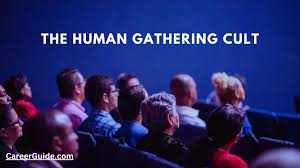Introduction to the Human Gathering Cult
Have you ever stumbled upon a group of individuals who seem to operate on an entirely different wavelength? A community bound by shared beliefs and practices, often shrouded in mystery? Enter the world of the Human Gathering Cult. This intriguing collective has drawn attention for its unique ideology and rituals that stand apart from mainstream society. As curiosity swirls around their gatherings, many wonder: What truly lies beneath this enigmatic facade? By peeling back the layers, we can uncover their origins, core beliefs, and the impact they have both on their members and society at large. Join us as we embark on a fascinating journey into understanding the Human Gathering Cult—a deep dive into its beliefs and practices awaits!
Origins and Founding of the Cult
The Human Gathering Cult traces its origins to a small community in the late 1990s. A charismatic leader emerged, preaching unity and shared purpose amid societal chaos. This vision resonated deeply with individuals seeking connection.
Initially, gatherings were informal—a mix of discussions and communal activities. As their numbers grew, so did their sense of identity. They adopted rituals that blended traditional beliefs with new age philosophies.
By the early 2000s, they had solidified around a structured hierarchy. Members were encouraged to devote themselves fully to the cause, often severing ties with outside relationships. This transition marked a shift from casual meet-ups to something more profound and serious.
The allure of belonging played a crucial role in attracting individuals searching for meaning in their lives. The cult’s foundations rested on vulnerability—turning personal struggles into collective strength through shared experiences and goals.
Beliefs and Practices of the Cult
The Human Gathering Cult centers its beliefs around a profound connection to community and the universe. Members often emphasize the importance of collective consciousness, believing that their thoughts can influence reality.
Rituals play a pivotal role in their practices. Weekly gatherings involve meditation, chanting, and sharing personal experiences. These sessions aim to foster emotional bonds among members while enhancing spiritual awareness.
Their philosophy encourages self-discovery through communal support. Followers participate in workshops focused on mindfulness, creativity, and holistic living. Such activities are designed to empower individuals within the group.
Members also adhere to strict guidelines regarding lifestyle choices. Many adopt vegetarian or vegan diets as part of their commitment to sustainability and compassion toward all beings. This dietary choice reflects broader ethical considerations intrinsic to their belief system surrounding interconnectedness.
Through these practices, they seek not only personal growth but also societal transformation by promoting love and unity among humanity.
Controversies sding the Culturrounthe human gathering cult
The Human Gathering Cult has attracted significant attention due to various controversies. Critics argue that the cult’s practices often blur ethical lines, raising concerns about manipulation and control over its members.
Allegations of abusive behavior have emerged. Former members describe experiences that range from emotional coercion to isolation from their families. These accounts paint a troubling picture of life within the cult.
Additionally, the organization’s stance on mental health has sparked debate. Some claim it promotes harmful ideologies regarding psychological well-being, discouraging professional help in favor of internal solutions.
Media portrayals often sensationalize these issues, leading to polarized opinions among the public. Supporters defend the group as a community focused on personal growth while detractors warn against potential dangers lurking beneath its surface.
Such controversies fuel ongoing discussions about freedom of belief versus protecting individuals from exploitation and harm.
Impact on Members and Society
The Human Gathering Cult exerts a profound influence on its members. Individuals often find a sense of belonging that they may struggle to achieve elsewhere. This communal bond fosters loyalty, leading many to dedicate their lives entirely to the group’s ideals.
However, this deep connection comes at a cost. Members frequently isolate themselves from friends and family outside the cult, which can strain personal relationships. The intense focus on group activities leaves little room for independent thought or external engagement.
Society feels the impact as well. The cult’s teachings and practices can challenge social norms, prompting moral debates around freedom and safety. Communities may react with skepticism or fear, creating barriers between members and non-members.
As these dynamics unfold, both individuals within the cult and society at large grapple with complex questions about identity, belief systems, and what it means to belong.
The Psychology behind Joining a Cult
The allure of a cult often lies in the promise of belonging. Many individuals seek connection and community, especially during times of loneliness or uncertainty. Cults offer a strong sense of identity that can be incredibly appealing.
Psychologically, the need for acceptance drives people towards these groups. Members find solace in shared beliefs and rituals that reinforce their commitment to the cause. This creates an illusion of safety and purpose.
Additionally, psychologically manipulating techniques play a role. Charismatic leaders use persuasive language and emotional appeal to draw members in. They foster dependency by isolating individuals from outside influences.
Fear is another powerful tool used within cults. By instilling fear about the world outside, they create an internal environment where leaving seems daunting and impossible.
This complex interplay between human needs and psychological tactics makes joining a cult both intriguing and dangerous.
How to Spot Warning Signs of a Dangerous Cult
Recognizing a dangerous cult can be challenging, but there are key warning signs to look for.
First, pay attention to the group’s leadership structure. If one person wields excessive control and discourages dissent, this is cause for concern.
Next, evaluate their communication style. Cults often employ manipulative language that creates an “us vs. them” mentality. This tactic isolates members from outside influences.
Also note the pressure placed on personal commitments. Members may feel compelled to sacrifice relationships or financial stability in favor of the group’s demands.
Additionally, observe how they handle questioning or criticism. A healthy environment welcomes discourse; a dangerous cult retaliates against those who dare speak up.
Consider the emotional climate within the group. High levels of fear or anxiety about leaving should raise red flags about its true nature and intentions.
Conclusion to the human gathering cult
The Human Gathering Cult presents a complex tapestry of beliefs and practices that attract individuals seeking connection, meaning, or belonging. Its origins reveal a unique narrative that intertwines with broader societal themes. While the community offers support and shared purpose to its members, the controversies surrounding it raise essential questions about autonomy and influence.
Understanding the psychology behind joining such groups reveals deeper motivations often linked to personal struggles or life transitions. Recognizing warning signs is crucial for those who may be vulnerable to manipulation or coercion.
As we reflect on this deep dive into the Human Gathering Cult, it’s vital for society to remain vigilant and informed. Awareness can empower individuals to make choices rooted in critical thinking rather than emotional impulse. Navigating these intricate dynamics requires an ongoing dialogue about belief systems and their impact on both individuals and communities at large.



